Free Download
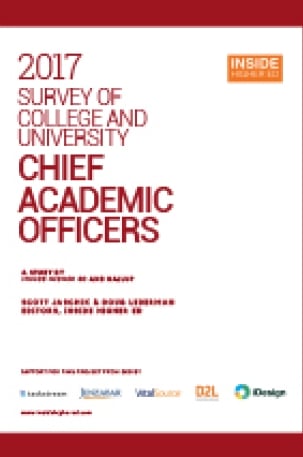
The provosts of American colleges and universities think the academic health of their institutions is quite strong, with 86 percent saying that it is either excellent or good. Twelve percent think their institutions' academic health (as they defined it) is fair, and only 1 percent each said it was poor or failing.
But while that finding might suggest provosts are feeling confident about how their institutions are fulfilling their many missions, that's not quite the case. When it comes to institutional effectiveness, the provosts are a good deal more critical.
About the Survey
Inside Higher Ed’s 2017 Survey of College and University Chief Academic Officers was conducted in conjunction with Gallup. A copy of the report can be downloaded here.
Inside Higher Ed regularly surveys key higher ed professionals on a range of topics.
On Feb. 15 at 2 p.m. Eastern, Inside Higher Ed Editors Scott Jaschik and Doug Lederman presented a free webinar on the survey. View the webinar here.
And when it comes to many of the larger challenges chief academic officers face, they aren't always confident.
At a time when many institutions are facing pressure to hire more minority faculty members, provosts are uncertain about whether their institutions and others will be able to meet targets for diversifying their faculties -- and a significant minority of provosts believe those targets are unrealistic.
At the same time, substantial majorities favor requiring at least one course on a diversity-related topic for all undergraduates.
A majority of provosts are concerned about reports that have intensified in the last year saying student evaluations of faculty members' teaching reflect bias against female and minority professors. But the provosts also report considerable reliance on those evaluations, and only some are considering changes in their processes.
And when it comes to the use of assessment, provosts are much more confident than are faculty members that the process is yielding improvements in teaching and learning. But provosts clearly are aware that many faculty members find assessment time-consuming.
These are some of the findings of the 2017 Inside Higher Ed Survey of College and University Chief Academic Officers, conducted by Gallup and answered by 654 provosts or chief academic officers. The academic leaders received complete anonymity on their responses, but their answers were coded by institution to allow for analysis by sector in some cases. You can download the full report on the survey's questions and responses here.
Diversifying the Faculty and the Curriculum
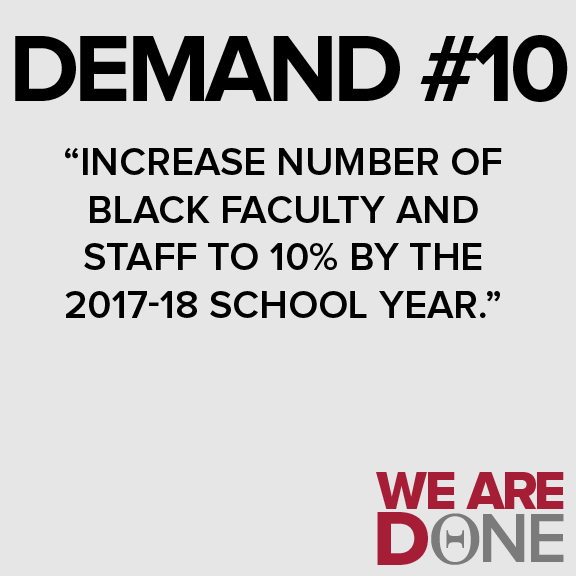 Many colleges and universities have for years been stating that they are trying to attract more minority faculty members. And for just as long, critics have been saying that colleges aren't doing all they can. This issue has taken on new urgency in the last two years as minority student protests on many campuses have demanded a more diversified faculty -- and many colleges have made specific pledges to hire more minority professors.
Many colleges and universities have for years been stating that they are trying to attract more minority faculty members. And for just as long, critics have been saying that colleges aren't doing all they can. This issue has taken on new urgency in the last two years as minority student protests on many campuses have demanded a more diversified faculty -- and many colleges have made specific pledges to hire more minority professors.
Those pledges differ widely but generally involve significant gains in diversity with timetables and targets. Provosts oversee the academic side of the house in higher education -- and are oftentimes being charged with making progress on these pledges, which is complicated by the decentralization of faculty hiring at many institutions. And the survey results suggest that the provosts have very mixed feelings about the realism of these targets, even if they admire the goals.
First, consider the starting point: a study released in November found that members of underrepresented minority groups held approximately 13 percent of faculty jobs in 2013, up from 9 percent in 1993. Yet they still only hold 10 percent of tenured jobs, according to the study. Women now hold 49 percent of total faculty positions but just 38 percent of tenured jobs. To the extent that student demands have focused on faculty rank, they are seeking progress in filling tenure-track lines, not adjunct positions. Further, many fear that the current round of initiatives, some of which involve wealthy, prestigious institutions, are more likely to result in moving around minority talent than growing its numbers.
Of the provosts surveyed, 24 percent (a slightly higher share in private higher education than in public) say their institutions now have specific targets for increasing the number or percentage of minority faculty members. The provosts also generally believe that their departments are trying hard. Asked if their academic departments "place a high value on diversity in the hiring process," 53 percent agree or strongly agree. Only 15 percent disagree or strongly disagree.
So are the provosts confident that we are about to see gains in minority faculty hiring? Not so much.
Some of the key findings:
- Asked if they are confident that they can meet their goals for minority faculty hiring, 31 percent of provosts agree or strongly agree that they can, while another 31 percent disagree or strongly disagree.
- Provosts are more likely to think that their targets are unrealistic (35 percent) than that they are realistic (29 percent).
- A large majority (62 percent) of provosts agreed or strongly agreed that "my college will need to make hiring decisions in new ways in order to achieve meaningful increases in the number of minority faculty members." Only 20 percent of provosts disagreed or strongly disagreed with that statement.
Provosts are also the lead administrators in working with faculty members on the curriculum -- another area receiving scrutiny from minority students and others concerned about diversity.
On this issue, the survey found wide support for efforts to add courses and programs related to diversity, and for requiring undergraduates to take courses that in some ways focus on diversity. Support was less strong for adding funds to departments that focus on the study of minority groups.
At the same time, the provosts strongly back the idea that curricular changes requested by minority students should be reviewed by the faculty, and not just agreed to by administrators. And across categories, private institution provosts were more supportive of shifts on diversity in the curriculum than were those in public higher education.
Diversity in the Curriculum
| Statement | % Agree - Private | % Disagree - Private | % Agree - All Public | % Disagree - All Public | % Agree - Community Colleges | % Disagree - Community Colleges |
| The curriculum at my college should be revised to add emphasis on diversity. | 45% | 23% | 40% | 26% | 36% | 26% |
| Undergraduates should be required to take at least one course dealing with diversity. | 80% | 8% | 69% | 17% | 64% | 20% |
| Diversity requirements improve the campus experience for all students. | 77% | 6% | 71% | 12% | 65% | 14% |
| Colleges should add support (e.g., money, positions) for departments that focus on the study of minority groups. | 32% | 27% | 25% | 38% | 19% | 42% |
| My college should add support (e.g., money, positions) for departments that focus on the study of minority groups. | 28% | 31% | 30% | 37% | 29% | 40% |
| Demands of student groups related to curriculum should be turned over to faculty bodies for review and action, and should not be acted on by administrators. | 56% | 20% | 58% | 27% | 50% | 31% |
In terms of diversity requirements, the survey suggests that provosts' attitudes are more supportive at institutions that already have them (52 percent of public institutions in the survey and 75 percent in private higher education).
Eighty-two percent of provosts at colleges with a diversity course requirement agree that undergraduates should be required to take a course on diversity, including 52 percent who strongly agree. That compares with 60 percent of provosts at colleges without a diversity requirement, with just 23 percent of CAOs at those schools expressing strong agreement.
Evaluations of Faculty Members -- and Concerns About Bias
Studies have been arriving with increasing frequency suggesting bias in the reviews students give of the professors who teach them. The bias is prevalent on sites like RateMyProfessors, a tool many students use to help pick courses and instructors. And the bias turns up elsewhere, in surveys colleges use to evaluate faculty members.
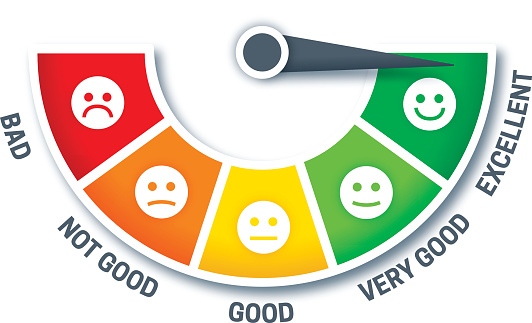 Perhaps of great significance, many of the recent studies (such as the ones described here and here) question whether student reviews of their professors correlate at all with other measures of teaching effectiveness. (Generally, the studies find, they don't.)
Perhaps of great significance, many of the recent studies (such as the ones described here and here) question whether student reviews of their professors correlate at all with other measures of teaching effectiveness. (Generally, the studies find, they don't.)
The survey results show that student evaluations of professors are -- whatever their validity -- important to the careers of faculty members.
Eighty-five percent of provosts report that their institutions use student evaluations when judging faculty members for tenure, promotion or raises. The figures are higher in private than in public higher education, but reflect solid majorities in all sectors.
In terms of the significance of the evaluations, 26 percent said that the student reviews were very important, and another 66 percent said that they were somewhat important.
Provosts are aware, the survey suggests, of the growing criticisms of the validity of these reviews. Nearly two-thirds (64 percent) are very concerned or somewhat concerned that the evaluations by students may not be accurate. And 50 percent are concerned that these reviews "may result in unfair criticism of female or minority faculty members."
This could be a period of reform for student evaluations. Thirty-two percent of provosts at public institutions and 53 percent at private institutions said they are reconsidering how they use student reviews of professors.
Tenure, Adjuncts and the Academic Job Market
Provosts tend to play a key role in approving tenure bids and setting policies for academic hiring. The survey suggests that many provosts are open to change on some issues but aren't necessarily pushing for change. On the issues of tenure and the reliance on those off the tenure track, provosts aren't expecting change.
Seventy-one percent of provosts (more in the public than the private sector) report that tenure "remains important and viable at my institution."
At the same time, 61 percent of provosts would favor a system of long-term contracts over the current tenure system.
Seventy-three percent also say that their institution relies "significantly" on non-tenure-track professors. And advocates for those off the tenure track frequently question the viability of the tenure system when smaller and smaller proportions of the faculty are on the tenure track.
Most provosts don't think their reliance on adjuncts will change in the years ahead -- if anything, they think their institutions will become more reliant on non-tenure-track faculty members.
Provosts' Predictions on Reliance on Adjuncts
| Private | All Public | Community Colleges | |
| Expecting less reliance on adjuncts | 6% | 14% | 4% |
| Expecting no change | 60% | 63% | 61% |
| Expecting greater reliance | 33% | 23% | 35% |
One solution that some see to the tight job market in many academic fields is to reduce the number of students admitted to Ph.D. programs, particularly those programs that have difficulty placing their graduates in good jobs.
Many administrations and faculty leaders consider this a third-rail issue and talk about it quietly, if at all.
Provosts appear to see this as a viable approach -- although it is unclear whether they will take action. But the survey found that 49 percent of provosts agree or strongly agree that graduate programs are admitting too many students. Only 30 percent disagree or strongly disagree.
The Liberal Arts and Career Preparation
Recent years have been difficult for liberal arts colleges and liberal arts disciplines alike. Many nonelite liberal arts colleges have struggled to attract students, and many of these institutions have shuttered some of their traditional majors, adding programs more closely aligned to career preparation. At many universities, liberal arts departments report being targets for elimination or budget cutting.
 Provosts, according to survey, are among the strongest supporters of the liberal arts (as a concept, not just liberal arts colleges). But provosts also have criticisms of the disciplines and a pessimistic view of the future of liberal arts colleges.
Provosts, according to survey, are among the strongest supporters of the liberal arts (as a concept, not just liberal arts colleges). But provosts also have criticisms of the disciplines and a pessimistic view of the future of liberal arts colleges.
Starting with the support: 90 percent of provosts agree or strongly agree (and 65 percent strongly agree) that liberal arts education "is central to undergraduate education -- even in professional programs." Support is weakest at community colleges, but even there, 81 percent of provosts agree or strongly agree with the statement.
But provosts do not see liberal arts colleges faring well in the years ahead. Fifty-four percent agree or strongly agree with the statement "I expect to see the number of liberal arts colleges decline significantly over the next five years." And 60 percent believe that "politicians, presidents and boards are increasingly unsympathetic to liberal arts education." Further, 45 percent of provosts believe that liberal arts education (across institutional types) is in decline.
For many provosts, a clear challenge for liberal arts education (at liberal arts colleges and in universities with broader missions) is a disconnect to the career goals of students (and the career hopes of parents).
Among the findings:
- One-third (33 percent) of provosts agree or strongly agree that liberal arts education "has become too divorced from the career needs of students and graduates." At community colleges, the share with this view is 45 percent.
- One-third (33 percent) also agree that "liberal arts faculty members are not sufficiently interested in the desire of parents and students for career preparation."
A Mixed Picture on Effectiveness in Undergraduate Education
The survey results show a continuation of a pattern of recent years: ask provosts how effective their institutions are at providing an undergraduate education, and they are pretty proud of their performance. But ask about specific facets of undergraduate education, and their self-evaluations become more critical. Many provosts lack that same confidence, for example, when it comes to how they assess student outcomes or use data to inform decisions.
At the same time, as the table below shows, provosts are very confident that their institutions are preparing students for the world of work -- even though pundits regularly question this. All but 1 percent of provosts said that their institutions were very effective or somewhat effective in this area.
A few items reveal significant sector differences. Provosts in private higher education are much less likely than their public counterparts to say they are doing a good job at controlling costs. When it comes to preparing effective citizens, private institutions appear more confident than their public counterparts.
Provosts’ View of Where Their Institutions Are ‘Very Effective’
| Area | Private | All Public | Community Colleges |
| Providing a quality undergraduate education | 69% | 66% | 68% |
| Preparing students for the world of work | 49% | 45% | 49% |
| Offering undergraduate support services | 47% | 47% | 45% |
| Recruiting and retaining qualified faculty members | 38% | 28% | 26% |
| Controlling rising prices for students and their families | 19% | 44% | 44% |
| Identifying and assessing student outcomes | 32% | 29% | 31% |
| Preparing students for engaged citizenship | 34% | 20% | 15% |
| Using data to aid and inform decision making | 20% | 31% | 30% |
Seeing the Value of Assessment, but Aware of Faculty Concerns
In recent years, in part because educators see value in assessment and in part because accreditors demand it, trying to measure student outcomes has become the norm for colleges. The survey results show that provosts are aware of the pressure but see assessment making a positive difference in teaching and learning.
Inside Higher Ed asked similar questions of faculty members (of all ranks and disciplines) in a survey released in October. Provosts are more positive about the impact of assessment than are their professors. The column for professors in the table that follows is all professors at all types of institutions.
Attitudes on Assessment
| Statement | % Private Provosts Agreeing | % Public Provosts Agreeing | % Community College Provosts Agreeing | % Faculty Agreeing |
| Assessment has improved the quality of teaching and learning at my college. | 56% | 46% | 50% | 27% |
| Assessment is more about keeping accreditors and politicians happy than it is about teaching and learning. | 20% | 35% | 37% | 65% |
The above comparisons may suggest that provosts and faculty members are disconnected on assessment. But some other answers on the provosts' survey show that they are aware of (even if they don't necessarily agree with) professors' concerns.
Asked if faculty members valued assessment at their colleges, only 35 percent said that was the case. Asked if faculty members view assessment as requiring a lot of work on their parts, 81 percent of provosts agreed.
But the key answer from the provosts that shows their belief in assessment may be the question about the actual use of assessment results: a healthy majority of provosts (59 percent) said that their colleges "regularly" make changes in the curriculum, teaching practices or student services based on assessment results. And a plurality of provosts (40 percent) believe that assessment has led to better use of technology in teaching and learning.
Other results of the survey suggest that faculty-provost relations could continue to be tested at many campuses.
- 69 percent of provosts said that most funds for academic programs will come from reallocation of current dollars, not new funds.
- 29 percent expect to cut academic programs in the next year.
- 48 percent said there was a "fundamental difference" in the perspective of faculty members and administrators.
To the extent provosts are looking for new sources of revenue and students, online offerings are likely to be a priority. Eighty-two percent of provosts said that they plan to increase emphasis on online offerings in the next year.
Trigger Warnings … After the Chicago Letter
The use of trigger warnings -- in which faculty members may tell students that a particular work they are about to read or view may by difficult emotionally -- is not new. Many professors say trigger warnings have been around for ages and are usually quite informal. More recently, some have urged faculty members to be more willing to offer these warnings, especially about works that may be difficult for some to read or view because of their portrayal of, for example, rape or racially motivated violence.
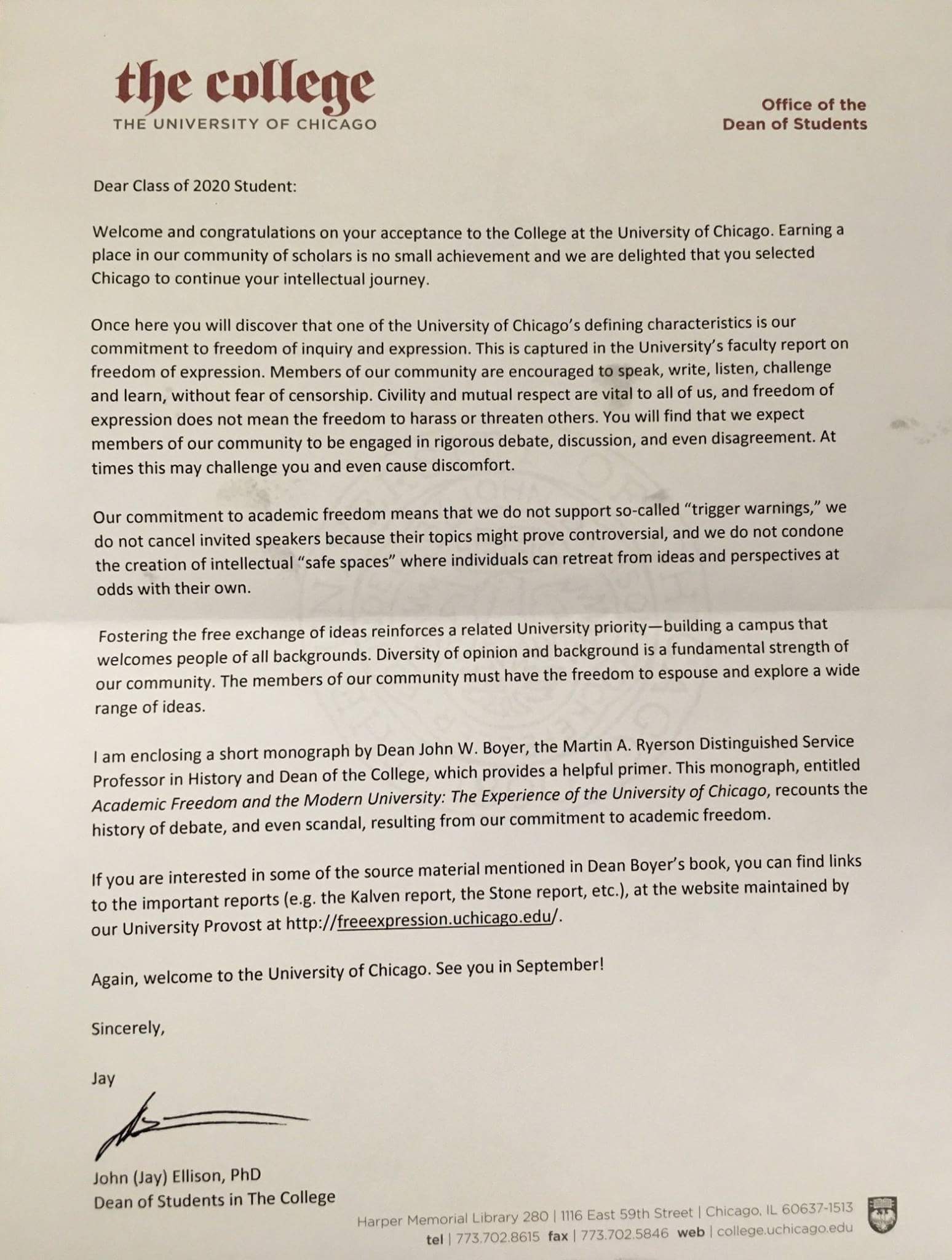 This fall, trigger warnings captured national attention when John Ellison, dean of students at the University of Chicago, sent a letter to incoming freshmen (at right) discussing Chicago's commitment to free expression. One line -- "our commitment to academic freedom means that we do not support so-called trigger warnings" -- left many with the impression that trigger warnings were required or widespread at other colleges.
This fall, trigger warnings captured national attention when John Ellison, dean of students at the University of Chicago, sent a letter to incoming freshmen (at right) discussing Chicago's commitment to free expression. One line -- "our commitment to academic freedom means that we do not support so-called trigger warnings" -- left many with the impression that trigger warnings were required or widespread at other colleges.
The provosts in this year's survey have a very different view of trigger warnings. While they are divided on their value, and many share Ellison's view of them, they view trigger warnings as an option for faculty members, not the subject of collegewide policy.
Only 1 percent of provosts report having any policy about trigger warnings. Ten percent of provosts say that colleges should require trigger warnings, but there is no sign those provosts are carrying the day at their institutions.
Provosts do have fears about the use of trigger warnings. Nearly two-thirds (65 percent) believe that trigger warnings could "discourage students from encountering important works of literature or art."
In terms of the way provosts view trigger warnings, they are slightly less negative this year than last, when Inside Higher Ed also asked about the issue.
In the 2015 survey, 35 percent agreed and 33 percent disagreed that trigger warnings are a useful tool for faculty members to use, compared with 36 percent who agree and 27 percent who disagree in the current survey. Last year, 58 percent agreed that trigger warnings are part of a trend of colleges going too far to protect students, compared with 53 percent in this year's survey.
Competency-Based Education
For several years, Inside Higher Ed has been asking provosts for their attitudes about competency-based education, in which students earn credit and degrees based on demonstrated abilities and knowledge, not time spent in classes.
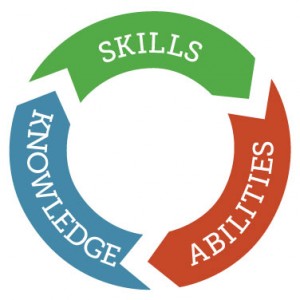 Each year, there has been growth in interest, but also a public-private split, with public higher education provosts far more supportive of competency-based education than are their counterparts in private higher education. This split may be logical given the pressure on public higher education to serve more students (without accompanying appropriations). But the trend continues despite the leadership role played by some private universities, such as Southern New Hampshire University, in advancing competency-based education.
Each year, there has been growth in interest, but also a public-private split, with public higher education provosts far more supportive of competency-based education than are their counterparts in private higher education. This split may be logical given the pressure on public higher education to serve more students (without accompanying appropriations). But the trend continues despite the leadership role played by some private universities, such as Southern New Hampshire University, in advancing competency-based education.
This year, 91 percent of provosts at public colleges and universities said they favored awarded credit through CBE (as competency-based education is frequently called). The figure was a healthy majority but only 72 percent at private colleges. The numbers have been creeping up a few percentage points each year.
Nearly two-thirds of public college and university provosts reported that their institutions currently award some academic credit based on demonstrated competence. The figure is only 38 percent for private higher education. (A key caveat is that the question was worded with a low bar -- with only some credit required, not a major program.)
The survey also suggests that CBE will continue to grow, as will the gap between public and private higher education on this issue.
Provosts at institutions that do not currently offer CBE were asked if their colleges and universities were exploring the idea. At public institutions, 49 percent said yes. At private institutions, the figure was only 26 percent.
Even as provosts show growing interest in CBE, they appear interested in the idea that out-of-classroom experiences may add significant educational value to those enrolled in traditional degree programs. They favor capstone projects and work with faculty members on research and study abroad. But the provosts see internships or actual work experience to be the most significant enhancement.
Percentage of Provosts Rating Enhancements ‘Extremely’ or ‘Very’ Effective
| Experience | % Private | % All Public | % Community Colleges |
| Internship/work experience | 89% | 90% | 89% |
| Research project with a professor | 87% | 71% | 57% |
| Study abroad | 78% | 59% | 50% |
| Intensive mentoring | 79% | 73% | 70% |
| Self-directed capstone project | 66% | 56% | 56% |
Glad They Entered Administration
Despite all the challenges facing provosts, most remain happy they became administrators.
The provosts are split on the extent to which their jobs are more focused on financial than administrative issues -- something that is a key issue for many in discussing their job satisfaction. Thirty-eight percent agree that the focus of their job is more financial than academic, but 37 percent disagree.
And 82 percent said that they are glad they pursued administrative work.